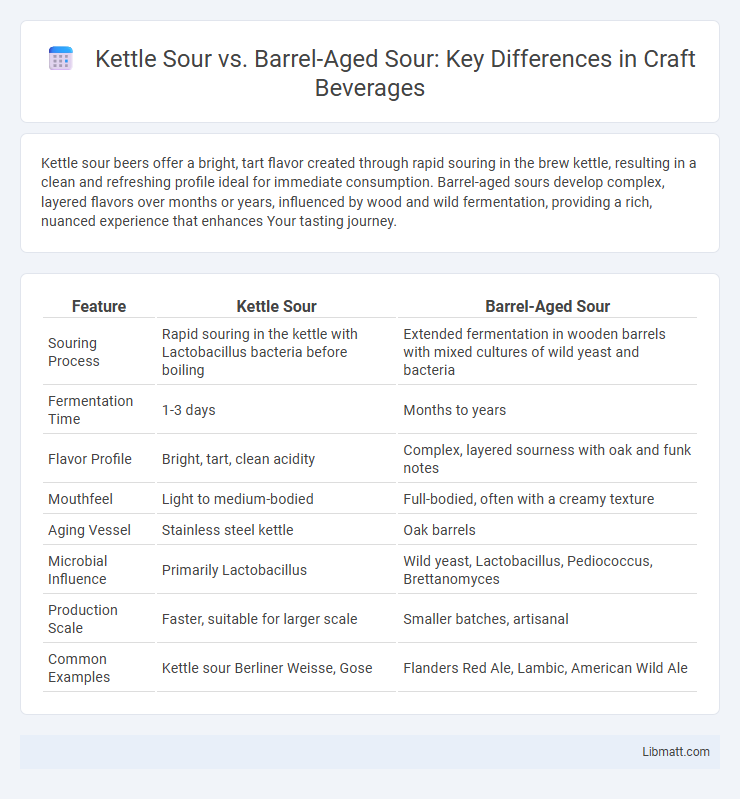Kettle sour beers offer a bright, tart flavor created through rapid souring in the brew kettle, resulting in a clean and refreshing profile ideal for immediate consumption. Barrel-aged sours develop complex, layered flavors over months or years, influenced by wood and wild fermentation, providing a rich, nuanced experience that enhances Your tasting journey.
Table of Comparison
| Feature | Kettle Sour | Barrel-Aged Sour |
|---|---|---|
| Souring Process | Rapid souring in the kettle with Lactobacillus bacteria before boiling | Extended fermentation in wooden barrels with mixed cultures of wild yeast and bacteria |
| Fermentation Time | 1-3 days | Months to years |
| Flavor Profile | Bright, tart, clean acidity | Complex, layered sourness with oak and funk notes |
| Mouthfeel | Light to medium-bodied | Full-bodied, often with a creamy texture |
| Aging Vessel | Stainless steel kettle | Oak barrels |
| Microbial Influence | Primarily Lactobacillus | Wild yeast, Lactobacillus, Pediococcus, Brettanomyces |
| Production Scale | Faster, suitable for larger scale | Smaller batches, artisanal |
| Common Examples | Kettle sour Berliner Weisse, Gose | Flanders Red Ale, Lambic, American Wild Ale |
Introduction to Kettle Sour and Barrel-Aged Sour Beers
Kettle sour beers are rapidly soured through lactobacillus fermentation directly in the brew kettle, producing a bright and crisp acidity within days. Barrel-aged sour beers undergo extended maturation in wooden barrels, often inoculated with wild yeast and bacteria, resulting in complex, layered flavors with deep funk and oak character. Both styles showcase distinct sour profiles shaped by their unique fermentation and aging processes.
History and Origins of Sour Beer Styles
Kettle souring, a modern technique gaining popularity in craft brewing, originated as a quicker way to control acidity by souring wort in the brew kettle before fermentation. Barrel-aged sours have a centuries-old tradition, tracing back to European monastic breweries where wild yeast and bacteria aged beer in wooden barrels, imparting complex, layered flavors. Your appreciation for sour beer deepens by understanding these distinct historical roots, highlighting innovation versus time-honored methods in sour beer production.
Key Differences in Production Methods
Kettle souring involves introducing Lactobacillus bacteria to the wort before boiling, allowing rapid acidification in a controlled environment, which results in a clean and bright sour flavor. Barrel-aged sours undergo spontaneous fermentation or inoculation with wild yeast and bacteria in wooden barrels, leading to complex microbial interactions over months or years that develop deep, layered acidity and funk. The primary difference lies in the speed and microbial diversity of souring: kettle souring is quick and controlled, while barrel-aging is slow and unpredictable.
Microorganisms and Fermentation Processes
Kettle sours rely primarily on Lactobacillus bacteria for rapid lactic acid fermentation within the brew kettle, often completed in 24 to 48 hours before boiling and yeast fermentation. Barrel-aged sours utilize a complex microbial consortium including Lactobacillus, Pediococcus, and Brettanomyces yeast, enabling extended fermentation and maturation that develop deeper acidity and complex flavor profiles. The controlled environment in kettle souring limits microbial diversity and aging time, while barrel-aging fosters symbiotic interactions and oxidative transformations over months to years.
Flavor Profiles: Brightness vs. Complexity
Kettle sours deliver a bright, tangy acidity with crisp, fruity flavors due to short fermentation and rapid souring processes. Barrel-aged sours develop rich complexity through extended aging, incorporating notes of oak, vanilla, and subtle funk from wild yeasts and bacteria. The contrast lies in kettle sours' immediate sharp brightness versus barrel-aged sours' multi-layered depth and mellow sourness.
Timeframes: Quick Brews vs. Patient Aging
Kettle sours achieve acidity within days by introducing lactobacillus prior to boiling, making them ideal for brewers seeking rapid turnaround without extended aging. Barrel-aged sours undergo months or even years of slow fermentation and maturation in wooden barrels, allowing complex flavors to develop through microbial interactions and oxygen exposure. The significant difference in timeframes defines their production approaches: quick brews offer tangy freshness, while patient aging delivers depth and sophistication.
Equipment and Cost Considerations
Kettle souring requires a separate kettle or fermenter for controlled lactobacillus fermentation, often making it more cost-effective with less aging space needed. Barrel-aged sours demand significant investment in oak barrels and long-term storage facilities, increasing both capital and operational costs. Equipment maintenance and longer turnaround times in barrel-aging generally lead to higher expenses compared to the quicker, more scalable kettle souring process.
Popular Examples of Each Style
Kettle sours like Russian River's Supplication and The Bruery's Tart of Darkness are popular for their bright, tart flavors created through rapid souring in the brew kettle. Barrel-aged sours, such as Cantillon's Classic Gueuze and Westbrook's Mexican Cake Sour, develop complex, deep acidity from extended aging in wooden barrels that foster wild yeast and bacteria fermentation. These styles represent distinct sour beer traditions, with kettle sours offering freshness and barrel-aged sours delivering rich, layered profiles.
Pairing Recommendations for Food and Occasions
Kettle sour beers, with their bright acidity and refreshing tartness, pair excellently with light dishes like salads, seafood, and spicy Asian cuisine, making them ideal for casual outdoor gatherings and summer picnics. Barrel-aged sours, offering complex flavors with deep funk and oak notes, complement rich foods such as charcuterie, aged cheeses, and roasted meats, perfect for intimate dinners or special celebrations. Understanding these pairing recommendations ensures your food and drink harmonize seamlessly, enhancing the overall tasting experience.
Choosing the Right Sour Beer for Your Palate
Kettle sours deliver a vibrant, tart profile with bright acidity and fresh fruit flavors due to rapid souring in the brew kettle, ideal for those seeking a crisp and approachable sour beer. Barrel-aged sours offer complex, layered tastes with sourness balanced by oak, funk, and aged character developed over months in wooden barrels, perfect for palates craving depth and subtle nuances. Selecting between these styles depends on whether you prefer immediate, sharp sourness or intricate, mellowed flavors shaped by extended aging.
Kettle sour vs barrel-aged sour Infographic

 libmatt.com
libmatt.com